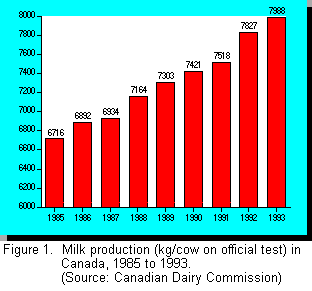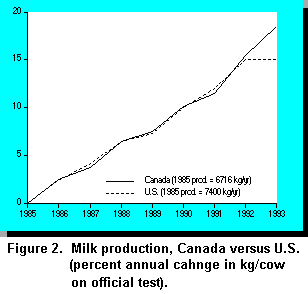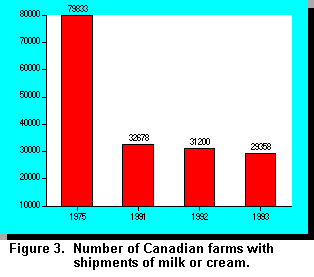
Take Home
Messages
Trying to plan for the future is much like a space traveller looking at a clear night sky. There are millions of possible destinations, but they are far away and by the time you arrive your destination world may be gone or completely changed. We must set a course today, but we must be prepared to alter that course and adjust to change. Some of our members may feel that some recent dairy policies have come from outer space, and feel a sense of weightlessness when trying to determine how to react to the changes that are taking place in our industry. Having been involved in most of the discussions surrounding the future of our industry, I will attempt to put my perspective on the course we might follow.
Dairy is seen by most governments as an essential part of a country's economy. There are a number of good reasons for the special status that dairy farming has gained in the minds of governments, particularly in western society. Within our culture milk is considered to be an essential part of a healthy diet, and obviously with good reason given the size and health of our young generation. As well, dairy farms provide for a strong social fabric, allowing viable farms on smaller areas, therefore boosting rural culture and social structure. These are principles that should not be lost by governments intent on economic reforms. Consideration must be given to the social cost of depopulation of rural areas through rationalization of existing farms. The influx of rural residents into cities has created very serious problems for those societies, for example, the situation in Mexico. In the context of trade, most countries are self-sufficient in dairy products, resulting in a very small percentage of production being traded on a world scale. Over the past twenty years, the export market has remained a dumping ground for excess production. Less than three percent of all world production is actually traded.
The United States and Europe have relied on massive government support in order to deal with surplus production. In Canada, dairy producers have shouldered the responsibility, accepting production control through a quota system, and financing surplus disposal through levies. This system has resulted in stable incomes for dairy farmers. Because of this stability, the dairy sector has not required ad hoc support to deal with volatile market forces, as has been the case with other sectors. As we know, the Uruguay round of GATT has changed the rules, leaving us trying to find new ways to maintain a healthy dairy industry in Canada.
It would appear that the attempt to reduce barriers to trade between provinces will continue. It will take great political will to succeed in this endeavor. Politicians are naturally expected to serve those who elect them, and a politician who fails to be elected is unemployed. If those constituents demand special consideration, provincial governments may attempt to protect some sectors of their economy from competition, or worse, attempt to break down national systems in the hope of attracting more activity to their own province. Until provincial political barriers are reduced (perhaps in the form of regional governments), total "free trade" will be difficult to develop, even between provinces. However, in dairy very few barriers stand in the way of open markets between provinces.
Sentiments for local autonomy are difficult to overcome. A sense of community is vital to the well being of any society, and a "Western" community is already a fact that should be exploited and nurtured, as part of a Canadian family. With our potential for growth and vast resources the opportunities are seemingly endless.
Efforts toward a "Western Pool" within a national system must be successful. Producers will cooperate with each other to achieve a fair system. We recognize the need for greater efficiencies in the processing sector that can only come with larger volumes and total utilization of processing facilities. There must be enough flexibility within the system to allow for those movements to occur. Production and processing must be permitted to move to where it can be done in the most competitive manner. It is the responsibility of governments to allow producers and processors, those with a financial and social stake in the industry, to make these decisions.
As far as bilateral trade is concerned, it is clear that the United States has a very selfish view of "trade" and will in all likelihood retain their protectionist stance. Their belief in an inherent right to our market is one of the greatest threats to our industry in Alberta. Our low dollar value gives us some short term protection. However, long term, we cannot compete with the enormous financial resources of the United States Treasury. We have costs that are directly related to production in Canada. The so-called level playing field does not, nor is ever likely to exist. Until all sectors of the economy are willing to accept this type of competition, dairy farmers have every right to demand protection from such threats.
There are a number of issues other than trade and politics that need to be considered when attempting to predict our future directions.
 It is difficult to imagine operating a
dairy industry without some form of production quota. The question is, who will control
these quotas and what values will they attract? We should remember that quotas are not
exclusive to the dairy industry. The college of Veterinary Medicine carefully restricts the
number of entrants per year into the program. Accountants are subjected to very rigorous
testing, and allowed a limited number of attempts to achieve status. Quotas are issued to
importers for the importation of products with low tariffs. These import quotas are highly
valued and traded among importers, some of whom never take part in the actual
importation of any goods whatsoever. Value of quota will be a function of milk prices and
other opportunities. We are fortunate in Alberta, in having alternatives to milk production
in agriculture.
It is difficult to imagine operating a
dairy industry without some form of production quota. The question is, who will control
these quotas and what values will they attract? We should remember that quotas are not
exclusive to the dairy industry. The college of Veterinary Medicine carefully restricts the
number of entrants per year into the program. Accountants are subjected to very rigorous
testing, and allowed a limited number of attempts to achieve status. Quotas are issued to
importers for the importation of products with low tariffs. These import quotas are highly
valued and traded among importers, some of whom never take part in the actual
importation of any goods whatsoever. Value of quota will be a function of milk prices and
other opportunities. We are fortunate in Alberta, in having alternatives to milk production
in agriculture.
Climate and land base permit farmers to diversify operations. Without the stability of a quota system and reasonable returns for the product, few farmers would be willing to make the financial and personal commitment necessary to operate a dairy. As producers committed to remaining in the dairy industry, low quota prices are a goal for which to strive. However, these values do represent, to some extent, the confidence producers hold in the industry.
The past twenty years have seen tremendous gains in productivity per cow, and per man hour. Supply management, often touted as a hindrance to these improvements, has in fact been a main factor in the success of Canadian dairy farmers to achieve both high levels of production and efficiency (see Figure 1 and Figure 2).
 The worldwide demand for Canadian
dairy genetics clearly indicates the success that our system has fostered. Sales of
Canadian dairy genetics are estimated at $100 million for 1994. With reasonable and
predictable returns, producers have adopted modern technology in upgrading milking and
housing facilities in order to produce a high quality product with less labor. The average
age of dairy producers is lower than in other agriculture sectors, demonstrating the
opportunities available for new entrants to the industry.
The worldwide demand for Canadian
dairy genetics clearly indicates the success that our system has fostered. Sales of
Canadian dairy genetics are estimated at $100 million for 1994. With reasonable and
predictable returns, producers have adopted modern technology in upgrading milking and
housing facilities in order to produce a high quality product with less labor. The average
age of dairy producers is lower than in other agriculture sectors, demonstrating the
opportunities available for new entrants to the industry.
Another trend that is evident, certainly here in Alberta, and to a lesser extent elsewhere, is the move away from government involvement, the so-called "privatization" of services. Although laudable in theory, and necessary in some areas, the long term results of this movement in the UK where it began under Thatcher, have in many areas been disastrous. In any market where a basic monopoly exists, governments must retain control. The secret of this being successful is in people retaining control of government. Some recent voter turnouts have shown the reluctance of the general public to take more time to be involved in the process of government rather than simply complaining about what the government does. In dairy, extension programs will continue to become more industry driven, either by suppliers or by farmers themselves through their organizations.
Numbers of dairy farms will continue to shrink, but not to the extent of past years (see Figure 3). Limits on size, population growth, and imports of dairy products will all influence industry size.
Bovine somatotropin and related biotechnology will continue to present difficult decisions
for the dairy industry, adoption being based more on political than scientific reasons. As
 the population becomes more and more
urbanized, animal welfare groups may gain more influence on public perceptions. It will be
extremely difficult to counteract such influence without appearing to be self-serving. This area
will present one of the most difficult challenges to agriculture in general.
the population becomes more and more
urbanized, animal welfare groups may gain more influence on public perceptions. It will be
extremely difficult to counteract such influence without appearing to be self-serving. This area
will present one of the most difficult challenges to agriculture in general.
Consumers will continue to demand cheaper and cheaper food, while at the same time attempting to restrict our ability to gain in productivity through the adoption of modern technology. The level of production per animal must eventually peak, as we approach the physical limits of feed intake and quality.
There is a tremendous opportunity to form partnerships between primary producers and other sectors of the dairy industry. Dairy farmers have demonstrated their willingness to join with processors in an effort to restructure our system so as to meet their requirements. We have developed programs to allow them to compete with imports and domestic competitors. The opportunity exists to greatly expand these combined efforts to the benefit of all sectors of the industry. We will continue to search for new ways to utilize our product, from blends with other foodstuffs, to niche markets. The field of transgenics also presents exciting new ground for market expansion.
In my view, there are two possible scenarios for the future policy direction of dairying in Alberta, and in Canada. Some basic principals will apply to both, but there are significant differences in outcomes. I should emphasize that these are my opinions, based upon my prejudice, but that's the advantage of making a presentation.
Scenario #1
Government, realizing the importance of rural infrastructure and stability and the role owner operated dairy farms can play, looks for ways to increase milk production from family farms across the province. Production of milk under quota is seen as a new way to share markets and eliminate the need for government bailouts, and a national system is constructed, touted as the "NEW MILK MARKETING PLAN" for Canada.
Scenario #2
Three regional pools are formed to supply the fluid market, and allow for rationalization of production facilities in order to meet import competition. A one quota system is established with greater flexibility to move quota across a region, and eventually across the country. Climatic change and population growth result in western industrial production being concentrated in the three prairie provinces, while fresh markets are served from local dairies. Stable prices tied to production costs are maintained to producers, as all share in the returns from all markets.
All or none of these predictions may come true, but whatever does come about should be based upon the will of the majority. Whatever weaknesses are inherent in the democratic system, they are insignificant relative to whatever other system we might adopt. If producers take the time to be informed, and make the effort to be involved, then the future of our industry will be in good hands. Dairy farmers must be allowed to make the decisions that affect both their economic and social future. It may sound trite, but we must not allow economists, urbanites, and politicians to set our agenda. We must develop policies that will benefit the country (government) and consumers (urbanites) and not worry about the economists. Dairy farming is more than dollars and cents, it is a way of life that should be defended.